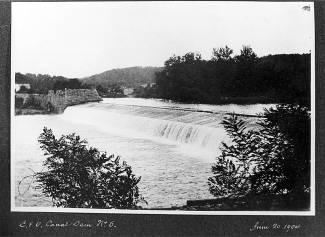Collection Name
About
Dam 6 was the head of navigation for the Chesapeake and Ohio Canal from 1842 until 1850. By 1850 the company had been able to raise funds and finish the last “50 miles” to what would be the terminus of the canal in Cumberland. The construction of the dam served multiple purposes which included: supplying the canal at regular intervals with river water, protection of the canal to high water and the creation of easily navigable river waters for a few miles upriver. Along with the construction of the Dam, a guard lock, flume and abutments were also built. The guard lock would enable water to be let into the canal through the inlet gates which were built very tall for protection against high water. Another use for the guard lock was for canal boat traffic in and out of the Slackwater area.
The need for a Dam near the Cacapon River was first recognized by the Chief Engineer of the Chesapeake & Ohio Canal Company, Charles B. Fisk, in 1835. By September of 1836 the Dam 6 contract had been awarded to Hollman and Reynolds. At the same time a contract was also awarded to George Weaver for the construction of the abutments and guard lock. Construction operations were to start that fall on the abutments and guard lock, while work on the dam did not start until the spring of 1837. George Weaver completed his contract by 1838, even with the constant issue with the lack of cement while the contract for the dam was deemed “abandoned” by 1838. With the work of company hands under the guide of Superintendent John R. Young the dam was completed by early 1839.
Even though Dam 6 was a solidly built structure it could not withstand the multiple floods and high water periods that plagued the Canal Company throughout operations. In the freshet of 1877 part of the abutments had to be rebuilt. In 1884, leakage forced the company to partially rebuild the dam. By 1886 a flood caused 237 feet of the Dam to fail. It would be reconstructed by Samuel D. Young of Cumberland. Again, in 1889 another freshet caused 100 more feet of the Dam to fail and be rebuilt. The company was proud that they had it back up and usable by 1891. Unfortunately, during the catastrophic flood of 1936 over half of Dam 6 was destroyed and washed away. The only remaining section was half of the wall, abutment and guard lock on the Maryland side.
Mile 134.2
SCC 7
Information from Harlan Unrau, Chesapeake & Ohio Canal Historic Resource Study, National Park Service.
A total of seven dams were constructed or rebuilt by the Chesapeake & Ohio Canal Company between 1828 and 1850. The purpose of the dams was to create a slack area in the river that could feed river water through inlet locks and into the canal bed. When canal water levels would fall making it difficult if not impossible for boat travel from Cumberland to Georgetown, the guard lock paddle gates would be opened in order to raise the water levels. Conversely, the guard lock served as a barrier between the frequent flood waters of the Potomac and the canal in order to protect the massive construction and engineering feat that is the C&O Canal.
